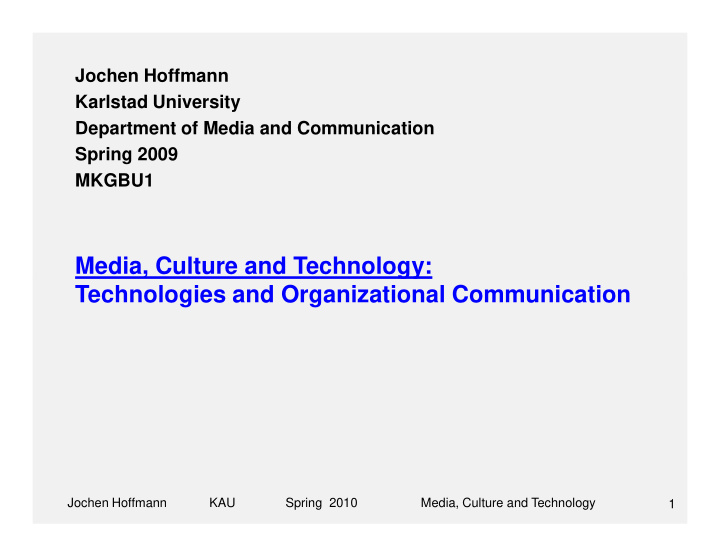



Jochen Hoffmann Karlstad University Department of Media and Communication Spring 2009 MKGBU1 Media, Culture and Technology: Media, Culture and Technology: Technologies and Organizational Communication Jochen Hoffmann KAU Spring 2010 Media, Culture and Technology 1
Exercise: Reflection on Technology Use Think of a communication technology you used for the first time within the last three years. � Why did you decide to use it? � What have been effects of the technology on your… � … daily routines? � … attitudes? � … social behaviour? � Did you expect these effects? Or is there anything that came as a surprise? Jochen Hoffmann KAU Spring 2010 Media, Culture and Technology 2
An Organization is a Social Entity that… � … has an address. � … has a goal. � … takes decisions. � … lacks self-awareness. Jochen Hoffmann KAU Spring 2010 Media, Culture and Technology 3
The Structure of Organizations New Technology Hierarchical Differentiation: Hierarchical Differentiation: Easy decision-making process Functional Differentiation: More sustainable decisions Claim Balancing both modes of differentiation Jochen Hoffmann KAU Spring 2010 Media, Culture and Technology 4
The Effect of New Technologies ? New Technology Reinforcing strata Reinforcing strata or planing hierarchies? Promoting functional differentiation or aiding organizational integration? Jochen Hoffmann KAU Spring 2010 Media, Culture and Technology 5
A Reciprocal Model Organization Organization effect launch New Technology use � � Selection of technology? Selection of technology? Feedback � Type of use? loop � Intended use according to declared purpose � Intended use not according to declared purpose � Unintended use Cumulative usage patterns Jochen Hoffmann KAU Spring 2010 Media, Culture and Technology 6
What is Special about New Media Technologies? � Digital storing of huge amounts of information � Easy access to information � Integration of multiple communication modes (text, graphic, sound, video) � Associative structure may complement sequential structure of information (hypertext). � Simultaneousness of storing of information and communicating � Supports both Push- and Pull-Strategies in communication management � High connectivity due to universal ”language” (TCP/IP) � Overcoming of time and space constraints (same or different time/place) � Applicable to both interpersonal and mass communication (1:1, 1:n, n:1, n:n) � Allows flexible switching between sender and recipient roles � And finally: If new media ought to be successful, they must not be new. Jochen Hoffmann KAU Spring 2010 Media, Culture and Technology 7
The Transformation Hypothesis „By using the Internet as a fundamental medium of communication and information-processing, business adopts the network as its organizational form.“ (Castells 2001: 66) New Technology Traditional Network Organization Enterprise Jochen Hoffmann KAU Spring 2010 Media, Culture and Technology 8
Characteristics of Networks � Autonomous elements � Loosely connected � Not enduring � Flexible scalability � Functional relations � Flat hierarchies � Self-organizing � Coordinating management � Representing ”modernism” � Diminishing organizational boundaries Jochen Hoffmann KAU Spring 2010 Media, Culture and Technology 9
The Constitutive Character of Structure Jochen Hoffmann KAU Spring 2010 Media, Culture and Technology 10
Project Orientation Replaces Organizational Boundaries PROJECT Organization Organization Organization „Thus, the network enterprise is neither a network of enterprises nor an intra- firm, networked organization. Rather, it is a lean agency of economic activity, built around specific business projects (…): the network is the enterprise “ (Castells 2001: 67) Jochen Hoffmann KAU Spring 2010 Media, Culture and Technology
Challenges for Network Enterprises � Economies of Scale Network structures allow for a customization of products and services. They comply less with the need for standardization which is necessary to reduce production costs. � Branding The autonomy of its elements impedes the chances of network enterprises to develop an inimitable identity and a clear brand. � Accountability If self-organizing network structures fail to operate properly, it will become difficult to identify the source of the problem and the social position which can be held to account. Jochen Hoffmann KAU Spring 2010 Media, Culture and Technology 12
Potential Effects of Communication Technologies on Hierarchies Bottom Up Top Down Access Open access Restricted access to relevant information Information storage Transparency Information overload Skills Inhouse trainings on new Digital divide technologies Specialisation Reduction of formal Emergence of informal hierarchies hierarchies Permeability Overleaping of hierarchy Communication triage levels Internal Monitoring Traceable collaborative Surveillance work External Monitoring Countercheck Violating privacy management positions Outgoing information „Polyglot“ external Public relations communication monopoly Scope for development Use of creativity enabling High regulation by use of software digital templates Jochen Hoffmann KAU Spring 2010 Media, Culture and Technology 13
New Communication Technologies as a Social Tool New communication technologies have no inbuilt social bias: � neither towards the strengthening of hierarchies � nor towards more democracy at the workplace. It is up to the people who use technologies as a tool. From a normative point of view, organizations are successful, if new communication technologies help them to find an appropriate balance between… between… Bottom-Up-Participation Top-Down-Leadership Challenging power structures Legitimizing power structures Individual freedom Organizational coherence Encouraging creativity Reliable standardization Enabling innovation Reliance on experience Jochen Hoffmann KAU Spring 2010 Media, Culture and Technology 14
Recommend
More recommend